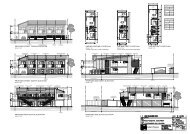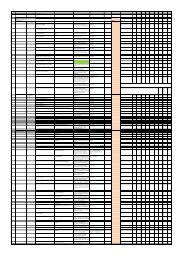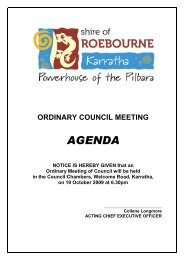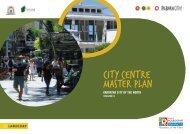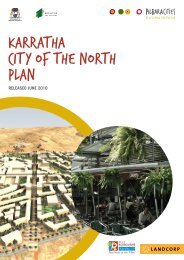Shire of Roebourne Local Planning Strategy
Shire of Roebourne Local Planning Strategy
Shire of Roebourne Local Planning Strategy
You also want an ePaper? Increase the reach of your titles
YUMPU automatically turns print PDFs into web optimized ePapers that Google loves.
<strong>Shire</strong> <strong>of</strong> <strong>Roebourne</strong> <strong>Local</strong> <strong>Planning</strong> <strong>Strategy</strong>Technical Report A1: Economic Development <strong>Strategy</strong>“At the most basic level, FIFO is about providing choice for workers. In a competitive labourmarket, employee choice is paramount. Choice <strong>of</strong> what job they do, who they work for and,importantly, <strong>of</strong> where they choose to live.” 3In the next few years, the majority <strong>of</strong> FIFO workers in WA will be involved in construction <strong>of</strong> new resourcesprojects and maintaining existing ones. Construction workforces are typically much larger and transientthan operational workforces, as many individual employees or contractors may only be required for ashort time. For example, ground surveyors may only be utilised at the start <strong>of</strong> a construction project,whereas fit-out specialists such as painters will generally be engaged near the completion <strong>of</strong> the project.Once their specialist task is complete, they then demobilise from the site.Large maintenance workforces are also <strong>of</strong>ten employed over short periods to undertake routinemaintenance tasks once a project is operational. These workers typically move from one worksite toanother across the state and the nation, utilising their specialist skills for a defined period <strong>of</strong> time.Operational workforces tend to be smaller, and their employment is generally for the longer-term andmore stable.In accommodating construction and maintenance staff, facilities typically are less permanent and <strong>of</strong>varying standards compared with those provided to operational employees, who have ongoingemployment, though the facilities may be used for multiple projects. Some facilities are not permanent,as companies, as well as local governments, naturally avoid the provision <strong>of</strong> accommodation forconstruction workers that is not suitable for long-term operational employees. This is not only importantfrom an economic point <strong>of</strong> view, but can also be important for communities, as it avoids the provision <strong>of</strong>un-needed accommodation that could adversely affect the local market, particularly in times <strong>of</strong> economicchange.It may also be the preference <strong>of</strong> communities to have construction camps located at site, or outside town,due to the potential disruption that could be created by having a large workforce in the community for ashort period <strong>of</strong> time.Limited research has been undertaken to qualify the impact <strong>of</strong> a non-resident population on importanthard infrastructure that sustains and builds communities i.e. roads, water, sewer, waste and socialinfrastructure that supports strong local communities i.e. community sport and recreation facilities,libraries, community events.Resource sectors expand and contract rapidly, <strong>of</strong>ten with little warning due to volatile commodity prices,which makes it difficult for councils to plan for and supply key community and emergency services.Community services such as general practitioners, emergency rooms, ambulances, hospitals,pharmacies, nursing services, dentists and police confront significantly increased levels <strong>of</strong> demand asFIFO workers are as likely to use these as local residents. The public benefit nature <strong>of</strong> many <strong>of</strong> theseservices, that is they are available to all participants in the community, results in the perception <strong>of</strong> theFIFO workforce is acting as “free-loaders”, utilising the services and facilities without being required tocontribute to the provision <strong>of</strong> the services and infrastructure. A resulting situation where these essentialservices are only provided to the level <strong>of</strong> “permanent” population benchmarks is that local residentsperceive under delivery <strong>of</strong> service in the local community and may be forced to travel to other larger townsto access these services.3The Chamber <strong>of</strong> Minerals and Energy Of WA, A Matter <strong>of</strong> Choice: Capturing the FIFO Opportunity in Pilbara Communities,April 201215




